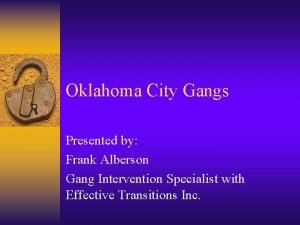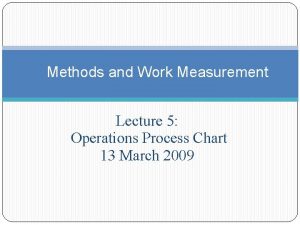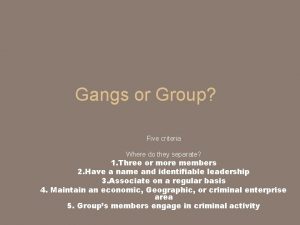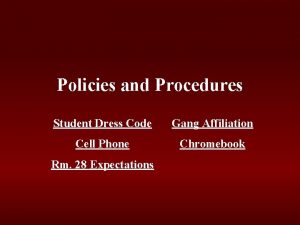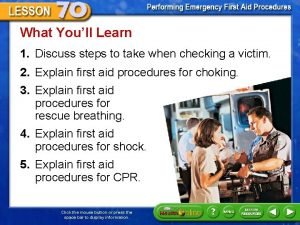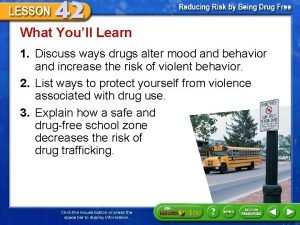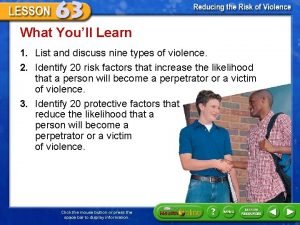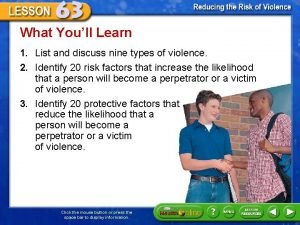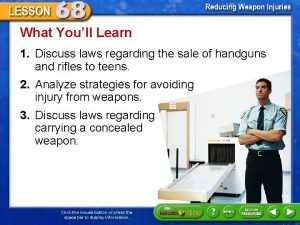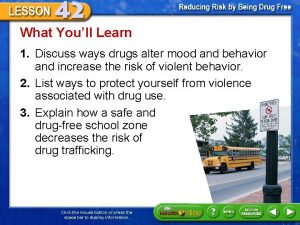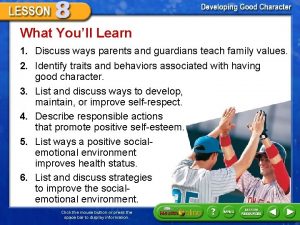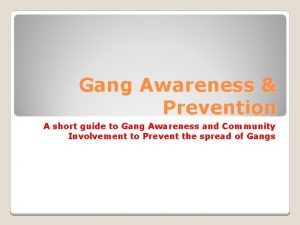What Youll Learn 1 Discuss characteristics of gang


































- Slides: 34

What You’ll Learn 1. Discuss characteristics of gang members. 2. Identify different roles of gang members. 3. Discuss reasons why it is risky to belong to a gang. 4. Explain how a gang can cause conflict in schools, families, and communities. Click the mouse button or press the space bar to display information.

What You’ll Learn 5. Analyze why teens join gangs. 6. Analyze and apply strategies to avoid gangs. 7. Explain how a teen who belongs to a gang can leave the gang. 8. Discuss reasons why some teens have become anti-gang members. Click the mouse button or press the space bar to display information.

Key Terms • gang • hard-core gang member • regular gang member • wanna-be • could-be • prestige crime • jumping-in • anti-gang Click the mouse button or press the space bar to display information.

Recognizing Gangs • A gang is a group of people involved in violent and illegal activities. • Gang members live in big cities, small cities, suburban, and rural areas, and come from families who have different income levels. • Most gang members have some common characteristics. Click the mouse button or press the space bar to display information.

How to Recognize Gangs • Gang members band together as a group. – Gang members hang out only with other gang members. • Gang members play specific roles. – Gangs have clear structures. – A hard-core gang member is a senior gang member who has the most influence. – A regular gang member is a gang member who belongs to the gang and obeys hard-core gang members. Click the mouse button or press the space bar to display information.

How to Recognize Gangs • Gang members play specific roles. – A wanna-be is a child or teen who is not a gang member, but who may wear gang clothing and engage in violent or criminal behavior because he or she wants to be a gang member. – A could-be is a child or teen who is interested in belonging to a gang. Click the mouse button or press the space bar to display information.

How to Recognize Gangs • Gang members follow specific rules. – Gangs have strict rules for the behavior of gang members. – These rules are set by the hard-core gang members. – There are harsh consequences for gang members who break the rules. Click the mouse button or press the space bar to display information.

How to Recognize Gangs • Gang members operate within a territory and refer to this territory as their “turf. ” – Gang members may injure and kill people, including members of other gangs, who trespass on their turf. – Gang members may draw graffiti on buildings to let others know it is their turf. Click the mouse button or press the space bar to display information.

How to Recognize Gangs • Gang members identify themselves with certain colors, types of clothing, or tattoos. – They may choose one specific color to wear or one particular item of clothing to wear, such as colored shoelaces. – Gang members may get tattoos to identify themselves as members of the gang for life. Click the mouse button or press the space bar to display information.

How to Recognize Gangs • Gang members have their own vocabulary, logos, and signals. – Gang members invent code words and ways to identify themselves as members of the gang, such as hand signals and handshakes, and graffiti, also called “tagging. ” Click the mouse button or press the space bar to display information.

How to Recognize Gangs • Gang members identify themselves by nicknames. – When people join gangs they are given a nickname, or street name, to disguise the gang member when he or she is involved in illegal activity. Click the mouse button or press the space bar to display information.


Why Gangs Are Risky • Belonging to a gang is risky. • Belonging to a gang often means that a gang member will have enemies. • Gang rivalry results in fighting, homicide, and other acts of violence. • Gang members have sought revenge against rival gang members for insults, “trespassing” on gang turf, and personal disputes. Click the mouse button or press the space bar to display information.

Why It Is Risky to Belong to a Gang • Revenge – If gang members feel they have been insulted or cheated they may seek revenge. – Revenge might include an assault or a drive-by shooting. – Family members of gang members are at risk as well, since gang members often retaliate against the family members of rival gang members. – Gang members often carry weapons to protect themselves. Click the mouse button or press the space bar to display information.

Why It Is Risky to Belong to a Gang • Crimes – Gang members might commit crimes to gain respect from other gang members. – A prestige crime is a crime committed to gain status from other gang members in the gang. – A gang member might assault another gang member, participate in a drive-by shooting, or steal in an effort to establish a tough reputation. Click the mouse button or press the space bar to display information.

Why It Is Risky to Belong to a Gang • Violence – Gang members also participate in violence against their own gang members. – Gang members who do not follow orders are beaten. Click the mouse button or press the space bar to display information.

Why It Is Risky to Belong to a Gang • Initiation – Teens who want to join a gang must go through an initiation period to prove they are “worthy” of gang membership. – Teens who are going through initiation often commit the most serious crimes, including murder, drug trafficking, or beating up or killing rival gang members. Click the mouse button or press the space bar to display information.

Why It Is Risky to Belong to a Gang • Initiation – Jumping-in is an initiation rite in which the potential gang member is beaten by gang members. – Initiation for females might involve being “sexed-in, ” or raped by one or more male gang members. – Sometimes, after a teen completes the initiation activities, they refuse the teen membership into the gang. Click the mouse button or press the space bar to display information.

Why Teens Join Gangs • There are many reasons teens give for joining gangs. • Teens might think gangs will provide something that they are lacking in their lives, or that gangs will provide a way to escape other problems. Click the mouse button or press the space bar to display information.

Myths About Gangs • I feel left out and the gang will help me feel like I belong. – Gangs may appear to be closeknit groups that offer a teen security and excitement. – Gang leaders believe they own their members and can use them to do whatever they want. – Gang members who break a rule might be injured or killed. Click the mouse button or press the space bar to display information.

Myths About Gangs • I can escape family problems by being in a gang. – Many gang members have been raised in homes with unstable families in which there is physical abuse, sexual abuse, drug abuse, and neglect. – Teens who think about joining a gang believe they will be escaping the abuse; however, these same abusive behaviors exist among gang members. Click the mouse button or press the space bar to display information.

Myths About Gangs • I can get money for the things I want by being involved in gang activities. – Teens may be attracted to gangs by the opportunity to earn money to help their families, but gang members make their money from drug trafficking, stealing, and other illegal activities. – Gang members are more likely to get a criminal record from these activities than to make money and also are at high risk of dropping out of school. Click the mouse button or press the space bar to display information.

Myths About Gangs • I get protection from gang members. – Gang members might offer to protect a member from others. – Once a teen is a member of a gang, the risk of harm and threats from others is greatly increased. – Involvement in drug trafficking and criminal activity, and assault from gang members and rival gangs increases the risk of being harmed. Click the mouse button or press the space bar to display information.

Protecting Yourself • It is risky to belong to a gang. • Tell a parent, guardian, or responsible adult if you are pressured to join a gang. • If a teen is involved in a gang, they may think there is no way out however, teens who are involved in gangs can leave. Click the mouse button or press the space bar to display information.

How a Gang Member Can Leave a Gang • Leaving a gang isn’t easy and may put the teens or their family members at risk for harm by gang members. • Many teens have successfully left gangs and started lives without gangs, violence, and fear. • Law enforcement officers and community gang counselors have helped protect many gang members who wanted to leave their gangs. • The best way to avoid having to leave a gang is not to join one in the first place. Click the mouse button or press the space bar to display information.

How a Gang Member Can Leave a Gang • Safety in numbers – Some teens who live in communities in which there are gangs have formed anti-gangs. – An anti-gang is a group of teens who stick together to avoid pressure and to protect themselves from gang members. – The goal of anti-gangs is for teens to continue with daily activities without being pressured or threatened by gang members. Click the mouse button or press the space bar to display information.

How a Gang Member Can Leave a Gang How to Protect Yourself from Gangs Avoiding gangs and gang members will help protect you from violence. • Stay away from gang members and avoid gang turf and places where gang activity takes place. • Do not stay out late at night. • Do not listen to music that supports gang activities. • Do not write graffiti. • Be aware of gang colors • Spend time with family members and mentors. in your community and in nearby communities. • Obey laws and respect authority. • Avoid alcohol and drugs. Click the mouse button or press the space bar to display information.

Study Guide 7 E 1. Identify the following statements as true or false. _______ Gangs have strict rules for the behavior of true members set by the hard-core gang members. _______ false Most gangs exist in inner-city communities. _______ false The best way to avoid having to leave a gang is to contact a law enforcement officer. _______ Gang members who do not follow orders true are beaten. Click the mouse button or press the space bar to display information.

Study Guide 7 E 2. What are three examples of crimes a teen might commit during initiation into a gang? Teens who are going through initiation often commit the most serious crimes, including murder, drug trafficking, weapons dealing, robbery, beating up other people, drive-by shootings, or beating up or killing rival gang members. Click the mouse button or press the space bar to display information.

Study Guide 3. How do gang members often identify themselves? Gang member often identify themselves with certain colors, types of clothing, or tattoos. Click the mouse button or press the space bar to display information.


Lesson Resources tx. healthmh. com/gangs tx. healthmh. com/study_guide

To navigate within this Interactive Chalkboard product: Click the Forward button to go to the next slide. Click the Previous button to return to the previous slide. Click the Lesson Resources button to go to the Lesson Resources slide where you can access resources, such as transparencies, that are available for the lesson. Click the Menu button to close the lesson presentation and return to the Main Menu. If you opened the lesson presentation directly without using the Main Menu, this will exit the presentation. You also may press the Escape key [Esc] to exit and return to the Main Menu. Click the Help button to access this screen. Click the Health Online Button to access the Web page associated with the particular lesson you are working with. Click the Speaker button to hear the vocabulary term and definition when available.

This slide is intentionally blank.
 Amateurs talk strategy professionals talk logistics
Amateurs talk strategy professionals talk logistics Revision techniques for kinesthetic learners
Revision techniques for kinesthetic learners Gang members nicknames
Gang members nicknames Characteristic of
Characteristic of The main characteristics of victorian poetry
The main characteristics of victorian poetry Pawsome gang
Pawsome gang Genu nervi facialis
Genu nervi facialis Nortenos in ogden utah
Nortenos in ogden utah S block gang
S block gang What gangs are in pueblo colorado
What gangs are in pueblo colorado Gang of four singleton
Gang of four singleton Wzorce projektowe gang of four
Wzorce projektowe gang of four What gangs are in oklahoma
What gangs are in oklahoma Blackwater london gang
Blackwater london gang Gang process chart example
Gang process chart example Left hand right hand chart example
Left hand right hand chart example şuurlu proprioseptif duyu nedir
şuurlu proprioseptif duyu nedir Material price variance
Material price variance Knox street posse
Knox street posse The gang plank
The gang plank Bandana color meanings gang
Bandana color meanings gang People nation
People nation Gang rules
Gang rules N tympanicus kimin dalı
N tympanicus kimin dalı Pls 13 gang
Pls 13 gang Gangs
Gangs Plexus cervicalis en önemli siniri
Plexus cervicalis en önemli siniri Gang dress code
Gang dress code Hari and the gang
Hari and the gang Sscc gang
Sscc gang Gran torino quotes
Gran torino quotes System flowchart
System flowchart Gang model
Gang model Gang system apush
Gang system apush Fabian oder der gang vor die hunde wien
Fabian oder der gang vor die hunde wien












